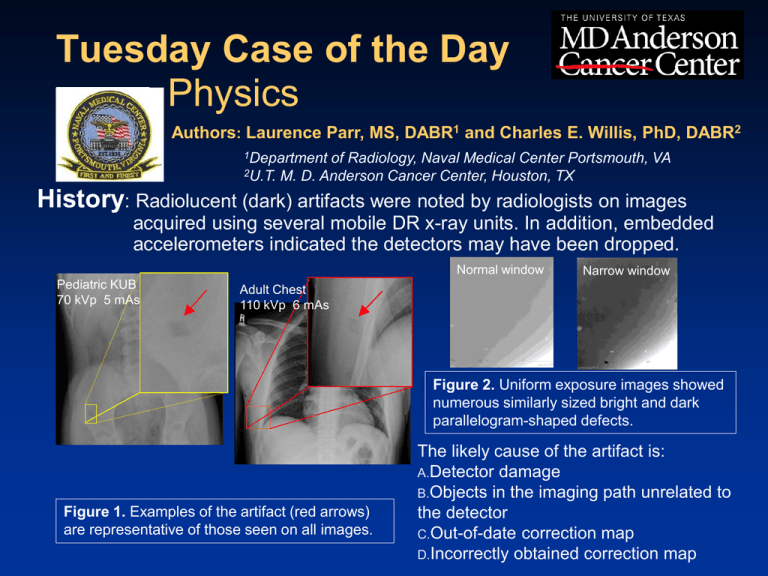Tuesday Case of the Day Physics Authors Laurence Parr, MS, DABR
advertisement

Tuesday Case of the Day Physics Authors: Laurence Parr, MS, DABR1 and Charles E. Willis, PhD, DABR2 1Department 2U.T. of Radiology, Naval Medical Center Portsmouth, VA M. D. Anderson Cancer Center, Houston, TX History: Radiolucent (dark) artifacts were noted by radiologists on images acquired using several mobile DR x-ray units. In addition, embedded accelerometers indicated the detectors may have been dropped. Normal window Pediatric KUB 70 kVp 5 mAs Narrow window Adult Chest 110 kVp 6 mAs Figure 2. Uniform exposure images showed numerous similarly sized bright and dark parallelogram-shaped defects. Figure 1. Examples of the artifact (red arrows) are representative of those seen on all images. The likely cause of the artifact is: A.Detector damage B.Objects in the imaging path unrelated to the detector C.Out-of-date correction map D.Incorrectly obtained correction map Findings: The detector was recalibrated according to the manufacturer’s directions. 1. After recalibration, a uniform exposure image acquired without moving the detector showed no artifacts (Fig. 3). Figure 3: Uniform Exposure – calibration orientation Handle Edge Handle Edge 2. A second uniform exposure image acquired after rotating the detector 180º showed numerous increased (dark) and decreased (light) signal artifacts (Fig. 4). Figure 4: Uniform Exposure – rotated180º Findings: (continued) 4. The correction map image (Fig. 5) showed focal regions of increased correction values that correlated with the increased signal artifacts (dark) on the rotated image (Fig. 6). 5. The decreased signal artifacts (light) did not correlate with the correction map. Figure 5: Correction Map – rotated 180º Handle Edge Handle Edge 6. Radial symmetry through the center of the 180º rotated image was noted between the dark and light artifacts (Fig. 6). Figure 6: Uniform Exposure – rotated180º Diagnosis: B. Objects in the imaging path unrelated to the detector Discussion: Reappearance of the artifacts after calibration when the detector was rotated indicates the source of the artifact is not fixed in position relative to the detector. If the source of the artifact had been fixed in position relative to the detector, recalibration of the gain map would compensate and the artifact would not reappear when the detector was rotated. This dark artifact is over-correction at the time of imaging in an area of the detector where low exposure existed at the time of calibration. Physical damage to the detector would have resulted in artifacts that maintained a fixed orientation with respect to the detector. Therefore, choice A. Detector damage is incorrect. Handle Edge Recalibration only corrected the problem so long as the detector orientation was maintained. Therefore, choice C. Out-of-date correction map is incorrect. This light artifact is an area of low exposure on the detector at the time of imaging where uniform exposure existed at the time of calibration. Calibration produced a gain correction map that was appropriate for the conditions of exposure, as demonstrated by the initial disappearance of the artifacts. Therefore, choice D. Incorrectly obtained correction map is incorrect. Figure 7: Light artifacts are focal spot images from the inverse pinhole effect. Dark artifacts are over-compensation in the gain correction map where focal spot images were present during calibration. Several small lead filings were found on the collimator exit window of the x-ray generator. After the filings were removed and the detector was recalibrated, the artifacts no longer appeared in any detector orientation. Discussion: The artifacts are, in fact, images of the focal spot of the x-ray generator, by means of the inverse pinhole effect. The artifacts have the typical “double-banana” shape of a focal spot image. Figure 8: Slit camera image of the focal spot (Jones 2008). A small amount of high Z material in the x-ray beam path, such as the Pb filings in the collimator exit window, can produce the image of the focal spot in the image receptor plane. This artifact was first reported in diagnostic radiology by Poznanski (1969). Figure 9: Xeroradiograph at 60 kVp and 40 mAs of an inverse pinhole array. The inverse pinholes are tungsten from 75 -300 micron in diameter arrayed in ten rows from left to right on a sheet of lucite (Cowart 1976). Note the distortion of the focal spot projection as lateral distance increases from the central ray of the x-ray beam. References/Bibliography: Cowart, RW. An investigation of the inverse pinhole camera. Thesis. University of Texas Health Science Center at Houston. Graduate School of Biomedical Sciences. Houston, TX. June 1976. 111 pages. Jones, AK. Personal communication. 2008. Poznanski, AK. Focal spot artefacts on breast radiographs. Radiology 92: 644. 1969.

